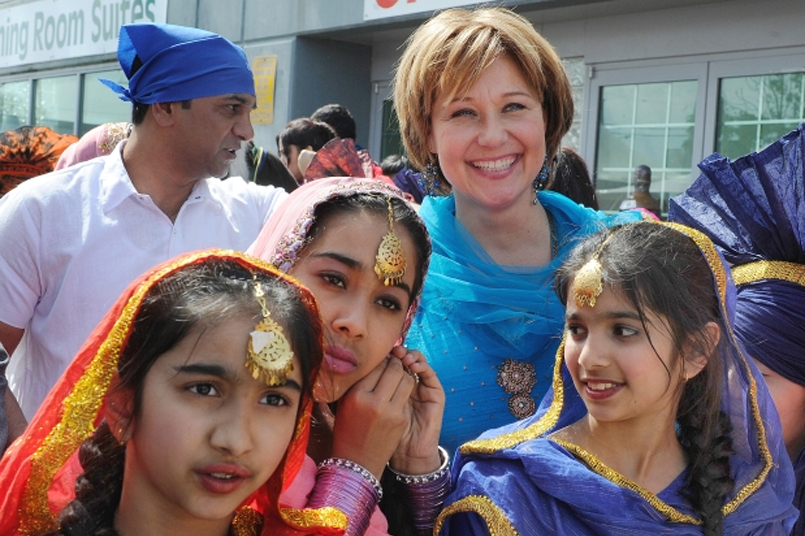
Politicians should try and understand Vaisakhi festival
Opinion: Keep Vaisakhi festival’s true meaning in mind during election
By Barj S. Dhahan, Special to The Vancouver Sun, originally published April 11, 2013
This week, preparations are underway for the popular Sikh festival of Vaisakhi. Sikhs from Amritsar to Abbotsford, Birmingham to Brampton, New York to Nankana Sahib are getting ready to celebrate this historic and deeply spiritual event.
While families are happily anticipating joining in the festivities including kirtan (singing of religious hymns), savouring samosas and Indian sweets, and performing bhangra, B.C. politicians are feverishly jockeying to find the best appearance spots at the Vaisakhi parades (in Vancouver April 13, and in Surrey April 20). They are also vying for the most opportune time to speak in the Sikh gurdwaras (temples). With at least 12 ridings in the province in which the Punjabi Sikh voters will decide the May 14 election outcomes, it is no wonder that politicians will try to curry favour with the Vaisakhi celebrants.
Political appearances at the parades are sure to be met with greater skepticism now than in the past due to the recent “ethnic strategy” controversy. And perhaps they should be. Perhaps we should take a moment to reflect on the true meaning of Vaisakhi so all British Columbians might participate in the festivities in a mindful and meaningful way.
Vaisakhi is a harvest festival and a time for thanksgiving. It has been celebrated in Northern India, Pakistan and other parts of the Indian sub-continent for thousands of years as a time to welcome the season of spring — a time for new life, growth and renewal. On April 13, 1699, Guru Gobind Singh, the 10th and the last Sikh guru, called on his followers to congregate at Anandpur (City of Bliss), Punjab for a special baptism ceremony to mark Vaisakhi. Following a dramatic ceremony, he called on his followers to adhere to certain rules, principles and values, and to courageously devote their lives to justice and equality.
On that day the Khalsa – “community of the pure” – was founded. Baptized Sikhs were to have an external appearance (the keeping of the five Ks — uncut hair, comb, bangle, sword and breeches) symbolizing inner contentment, purity of intention and commitment to pursuit of truth. Behaviours, such as not disturbing the natural growth of hair and not consuming alcohol or other intoxicants and living with restraint, were encouraged.
More relevant to this discussion, all Sikhs, whether baptized or not, are to respect themselves and others, to recognize all people as equals, to earn an honest living, to give to charity, not to cheat or lie, to seek social harmony and to be engaged in the affairs of the world — economic as well as political.
B.C. voters, then, should not be surprised by the nearly 25 candidates of Punjabi-Sikh heritage running in this election. There are at least 12 candidates for the NDP, six for the Liberals, three for the B.C. Conservatives, one for the Greens and one independent.
Vaisakhi is not just a parade or a time to be seen. It is a day to celebrate the values above and to examine our intentions going forward. It is a time for renewal of self and a commitment to work for the greater good.
The Guru called on his followers to self-reflect, to respect their communities, to struggle for equity and equality and to build peace. It is important to reflect on these values and how they may impact our voting choices. These values may help us discern what the important issues are in this election and which party and candidates are best able to address them with a clear vision for the province.
Which party will genuinely work toward environmental sustainability while ensuring economic opportunity for all? How might our vote contribute to creating a safe and respectful community, how will it promote tolerance and inclusion, and how will it help eradicate discrimination based on economic, gender, religious, ethnic or any other difference?
In light of the upcoming campaign with the expected negative attack ads, we would be wise to study and reflect on who might best carry out these values as our representatives and legislators. I hope each participant in this year’s parades will take some time to do just that.
Barj S. Dhahan is national chair of the Canada India Foundation and director of the Canada India Education Society.
This op-ed article was originally published in The Vancouver Sun on April 11, 2013.

